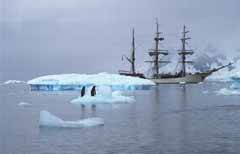
Mysterious Antarctica may be the home of the oldest civilization
Lots of surprises may be hidden under the Antarctic ice and are waiting to be discovered by humans
 The existence of the prehistoric
civilization in Antarctica started drawing attention of professional
historians after the World War II. The hypothesis can be proved by the
medieval maps and research of the Western paleogeologists and
glaciologists.
The existence of the prehistoric
civilization in Antarctica started drawing attention of professional
historians after the World War II. The hypothesis can be proved by the
medieval maps and research of the Western paleogeologists and
glaciologists.
In January 1820 the lieutenant of the Russian
Imperial Fleet Mikhail Lazarev discovered a new continent. At the
beginning of the 20th century famous Russian Brockhaus and Efron
encyclopedic dictionary contained an article, according to which the
continent was insufficiently explored
and that there were no flora and fauna. Besides, the author mentioned
the variety of seaweeds and sea animals that inhabited the Antarctic
waters.
About twenty years later the head of the Istanbul
National Museum Halil Edhem found an old map while revising the library
of Byzantine emperors in the old sultans palace. The author of the map
depicted the Western coast of Africa, the Southern coast of South
America and the Northern coast of Antarctica. Halil was astonished. The
ice edge of the Queen Maud Land south of 70th parallel was free of ice.
The author mapped a mountain chain at this point. The name of the
cartographer was well known to Edhem. It was the admiral of Ottoman
Empire Fleet Piri Reis, who lived in the first half of the 16th
century.
In 1949 the joint British-Swedish expedition conducted a thorough seismic exploration of the southernmost continent through the thick ice.
The results coincided with the map of Reis. However, it was a mystery
how the map data were to agree with the level of science of 1513.
Piri Reis himself explained on the margins of the map
that the map was based on a lot of previous sources, some of which
belonged to his contemporaries, while others could be dated with as
early as the 4th century B.C. One of thу sources, for instance, belonged
to Alexander the Great. Thus Reis could not be made responsible for the
data presented on the map.
Medieval maps show Antarctica without ice cover or
partly covered with ice. The accuracy of maps of the 16th century is
incredible. In terms of the technical means their data can be compared
with those of the end of the 18th century and sometimes with those of
the 20th century.
According to the Reis's map the coastal edge of the
continent is not covered with ice. Oronteus Finius's map that was
composed 18 years later shows plateau-glacier
around the South Pole within the 80th and sometimes 75th parallels. 200
years later academician Buache depicted Antarctica without the ice.
In 1949 the admiral Berd's expedition was drilling
the Ross Sea bottom approximately in those places where Finius marked
the riverbeds. The cores contained fine-grained rocks, well-mixed
deposits, brought into the sea by the rivers, the heads of which are
located in the middle latitudes (i.e. not covered with ice).
Scientists
of Carnegie Institute of Washington managed to establish precisely that
Antarctic rivers that contained these deposits were flowing about 6000
years ago. Only after that, about 4000 B.C. the ice began accumulating
at the bottom of the sea. This fact was preceded by a long period of
warmth.
As a result, the maps mentioned above depict Antarctica of the period when Egyptian and Sumerian civilizations were born. Most of the historians disclaim this point of view.
However, there is a hypothesis that between the fifth
and the tenth millenniums B.C. a human civilization lived on the
planet. It possessed great knowledge in navigation, cartography,
astronomy, thу level of which was not lower then of that of the 18th
century.
This civilization was rather a predecessor of the
ours than a product created by aliens. Its age could be several
millenniums. It was probably located on the northern coast of the
southernmost continent or the archipelago of large islands – that was
Antarctica that had a moderate climate at that time. Later it could
occupy the northeast of the African continent.
The civilization could have disappeared because of
the icing up of the southern land that began not earlier than in the
tenth millennium B.C. Another possible reason could be large inundations
that led to long-lasting local floods, which are not disclaimed by archaeologists.
Such natural disasters could destroy almost the whole material culture
of the protocivilization. It can be possible that some part of it is
covered with thick Antarctic ice. Another possibility is that some of
the representatives of this protocivilization could have survived. In
this case they could have pass their knowledge to Egyptians and
Sumerians.
Humans cannot but hope that further archaeological
research will solve the mysteries of the southernmost continent. There
could be lots of surprises hidden here.
Vladimir Averianov


No comments:
Post a Comment